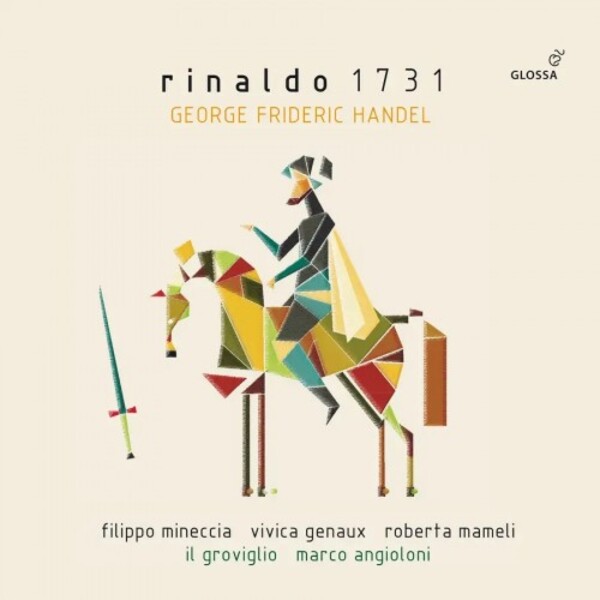HANDEL Rinaldo (1731 version. Angiolini)
View record and artist detailsRecord and Artist Details
Genre:
Opera
Label: Glossa
Magazine Review Date: 06/2025
Media Format: CD or Download
Media Runtime: 157
Mastering:
DDD
Catalogue Number: GCD924802

Tracks:
| Composition | Artist Credit |
|---|---|
| Rinaldo |
George Frideric Handel, Composer
Filippo Mineccia, Rinaldo, Countertenor Francesca Martini, Siren, Soprano Il Groviglio Logan Lopez Gonzalez, Argante, Countertenor Marco Angiolini, Goffredo, Tenor Marco Angiolini, Conductor Michele Mignone, Christian Magician, Bass Roberta Mameli, Almirena, Soprano Vivica Genaux, Armida, Contralto |
Author: David Vickers
Towards the end of the 1730‑31 season Handel put on a radical reworking of his first London opera, Rinaldo. His cast did not include any of the original singers, they were fewer in number and their voice-types were incompatible to the score without widespread changes. Just eight numbers were retained without alteration and sung by the same character in their original position (as were the overture and the closing chorus). As well as transpositions galore, some arias were reassigned to different characters. Handel inserted five arias from Lotario (1729), one from Partenope (1730), a showpiece for Strada from the 1730 revival of Giulio Cesare and an aria from Admeto (1727). The only brand-new music was an extensive accompanied recitative – a creation for Senesino in which the title-hero contends with sorcerous obstacles in an enchanted forest (‘Orrori menzogneri’, Act 3 scene 7). The Saracens Armida and Argante do not convert to Christianity (as they did in 1711) but instead flee unrepentantly in a dragon-drawn chariot.
Never recorded before, the 1731 version is performed spiritedly by Il Groviglio, conducted by tenor Marco Angioloni (who sings the part of Goffredo). The tiny string band of merely nine players (five violins, two violas and only one cello and double bass) is less than half of Handel’s own theatre orchestras. Its smallness causes imbalances, such as underpowered strings in the overture swamped by a pair of oboes, one bassoon and a trio of plucked continuo. Filippo Mineccia’s florid fireworks in Rinaldo’s ‘Venti, turbini’ (dropped down to F major for Senesino) are dispatched energetically; the concertante violinist and bassoonist are superb, although tutti strings are hardly discernible. ‘Cara sposa’ is undermined by perfunctory single violins and viola devoid of contrapuntal shaping. Mineccia declaims the accompagnato ‘Orrori menzogneri’ vividly, but there is conspicuous lack of momentum in the faltering segue into ‘Vedrò più liete’ (an admittedly anticlimactic Lotario aria). Roberta Mameli has a charming synthesis of agility, melodic charm and stylistic finesse in Almirena’s ‘Augelletti che cantate zeffiretti’ (the piccolo recorder’s harshness and solo viola’s clipped separation prohibit pastoral serenity), and her witty high-wire singing, nuanced unison violins and dancelike bass lines are marvellous in ‘Parolette, vezzi e guardi’, even if Cleopatra’s flashy flirtatiousness is irrelevant to the imprisoned Almirena’s circumstances.
Vivica Genaux’s viciousness in Armida’s ‘Furie terribili’ is spikily aspirated (a clumsy orchestral trill is blighted by wrong notes). A few moments of trenchant vibrato and unreliable tuning do not diminish the fun offered by Handel’s rewriting of ‘Combatti da forte’, transferred from Almirena to Armida and rescored with pairs of horns and oboes that are played splendidly. The sorceress’s vengeful curses upon her final departure have unrelenting intensity in ‘Fatto è Giove un dio d’inferno’ (an aria cut from Handel’s recent December 1730 revival of Partenope, given a new home with its words altered). Logan Lopez Gonzalez and the continuo team do an attractive job in Argante’s ‘Sulla ruota di fortuna’; the text espousing virtue, sung originally in 1711 by the crusading sidekick Eustazio, makes no sense for the dastardly king of Jerusalem’s antagonistic parley. Goffredo’s ‘Sovra balze scoscese e pungenti’ and ‘D’instabile fortuna’ (another Lotario aria) are undermined by Angioloni’s injudicious embellishments that do not fit the band’s harmonic direction of travel, and the tenor lags behind the beat throughout much of ‘Mio cor che mi sai dir?’. Irrespective of plausible reasons why the 1731 Rinaldo hasn’t caught on despite occasional concert and staged performances in recent years, Glossa’s booklet libretto should not have omitted vital stage directions, scene descriptions and act/scene numbers.
Discover the world's largest classical music catalogue with Presto Music.

Gramophone Digital Club
- Digital Edition
- Digital Archive
- Reviews Database
- Full website access
From £8.75 / month
Subscribe
Gramophone Full Club
- Print Edition
- Digital Edition
- Digital Archive
- Reviews Database
- Full website access
From £11.00 / month
Subscribe
If you are a library, university or other organisation that would be interested in an institutional subscription to Gramophone please click here for further information.




